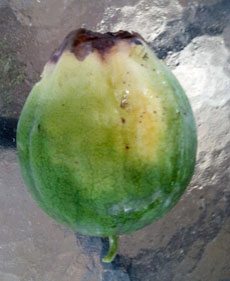Melon Blossom Rot - Fixing Blossom End Rot In Melons


Melon blossom end rot can discourage the gardener, and rightly so. All the work in getting the garden ready, planting, and caring for your melons may seem in vain when prized melons develop melon blossom rot.
Preventing Melon Blossom End Rot
This disease occurs when the end of the fruit that was attached to the bloom is deprived of calcium at a critical point in development. Small spots appear that may enlarge and become infected by other diseases and entered by insects. Preventing melon blossom end rot is something most gardeners aspire to. Blossom end rot in melons can be prevented by following these suggestions:
Soil Testing
Take a soil test before you plant the garden to learn the pH of your garden soil. Your local Cooperative Extension office will have you bring in your soil sample and get it back to you with a detailed nutrient analysis, including the availability of calcium in the soil. A soil pH of 6.5 is what most vegetables need for optimum growth and preventing melon blossom end rot. The soil test may advise you to amend the soil to raise or lower the pH. Fall is a good time to test the soil as this allows time to add needed amendments and let them settle into the soil before spring planting. Once the soil is properly amended, this should help fix melon blossom rot and problems with other vegetables. The soil analysis may recommend adding lime if the soil is lacking in calcium. Lime should be applied at least three months before planting; at 8 to 12 inches (20-31 cm.) deep. Take a soil test every third year to keep a check on pH and alleviate considerations such as melon blossom end rot. Problem soil should be tested annually.
Consistent Watering
Water consistently and keep the soil moist. Soil that inconsistently fluctuates from moist to dried out during any stage of development of the melon flower or fruit may result in melon blossom end rot. Varying moisture levels causes uneven uptake of calcium, which causes blossom end rot in melons, tomatoes and some other fruits and vegetables. Blossom end rot in melons can happen even when there is adequate calcium in the soil, all that is needed to cause this unsightly disease is one day of inadequate watering when the fruit is beginning to form or when blossoms are developing.
Limiting Nitrogen
The majority of the calcium taken up by the plant goes to the leaves. Nitrogen encourages the growth of leaves; limiting nitrogen fertilizer can decrease leaf size. This may allow more calcium to be directed toward the developing fruit, which can discourage blossom end rot in melons. Blossom end rot in melons can be deterred by planting melons in well-draining soil to encourage a deep and large root system that will take up more calcium. Mulch around plants to help hold moisture. Fix melon blossom rot by following these practices and harvest undamaged melons from your garden.
Sign up for the Gardening Know How newsletter today and receive a free copy of our e-book "How to Grow Delicious Tomatoes".

Becca Badgett was a regular contributor to Gardening Know How for ten years. Co-author of the book How to Grow an EMERGENCY Garden, Becca specializes in succulent and cactus gardening.